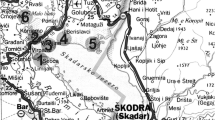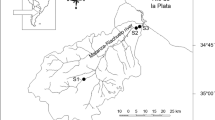Abstract
Cadmium, copper and lead concentrations were surveyed in several species of submerged aquatic macrophytes in a Precambrian Shield Lake. Values were variable within each species and interspecific differences in metal concentration were not significant over the season as a whole. Cadmium concentration increased during the season in Potamogeton foliosus and Myriophyllum exalbescens, while copper and lead declined in P. foliosus. No identifiable seasonal trends were seen in P. zosteriformis and P. robbinsii. In P. foliosus, copper and lead concentrations increased with water depth. Few significant correlations were found between metal concentrations in the shoots and each of several water chemistry parameters, temperature, and shoot chlorophyll, soluble sugar and starch content. Roots yielded greater metal concentrations than shoots.
Similar content being viewed by others
References
Adams, F. S., D. R. MacKenzie, H. Cole Jr. & M. W. Price, 1971. The influence of nutrient pollution levels upon element constitution and morphology of Elodea canadensis Rich. in Michx. Envir. Pollut. 1: 285–298.
Adams, F. S., H. Cole Jr. & L. B. Massie, 1973. Element constitution of selected aquatic vascular plants from Pennsylvania: submersed and floating leaved species and rooted emergent species. Envir. Pollut. 5: 117–147.
Allenby, K. G., 1968. Some analyses of aquatic plants and waters. Hydrobiologia 32: 486–490.
American Public Health Association, 1985. Standard Methods for the Examination of Water and Wastewater. Am. Publ. Health Assoc., Washington DC. 1268 pp.
Aulio, K., 1980. Accumulation of copper in fluvial sediments and yellow water lilies (Nuphar lutea) at varying distances from a metal processing plant. Bull. envir. Contam. Toxicol. 25: 713–717.
Behan, M. J., T. B. Kinraide & W. I. Selser, 1979. Lead accumulation in aquatic plants from metallic sources including shot. J. Wildl. Mgmt. 43: 240–244.
Cearley, J. E. & R. L. Coleman, 1973. Cadmium toxicity and accumulation in Southern Naiad. Bull. envir. Contam. Toxicol. 9: 100–101.
Cowgill, U. M., 1973. The determination of all detectable elements in the aquatic plants of Linsley Pond and Cedar Lake (North Branford, Connecticut) by X-ray emission and optical emission spectroscopy. Appl. Spectroscopy 27: 5–9.
Cowgill, U. M., 1974. The hydrogeochemistry of Linsley Pond, North Branford, Connecticut. Arch. Hydrobiol. Suppl. 45: 1–119.
Dietz, F., 1972. Enrichment of heavy metals in submerged plants. Adv. Wat. Pollut. Res., Proc. 6th Int. Conf. Wat. Pollut. Res. 6: 53–72.
Gale, N. L., B. G. Wixson, M. G. Hardie & J. C. Jennett, 1973. Aquatic organisms and heavy metals in Missouri's New Lead Belt. Wat. Resour. Bull. 9: 673–688.
Harding, J. P. C. & B. A. Whitton, 1978. Zinc, cadmium and lead in water, sediments and submerged plants of the Derwent Reservoir, northern England. Wat. Res. 12: 307–316.
Hutchinson, T. C., A. Fedorenko, J. Fitchko, A. Kuja, J. Van Loon & J. Lichwa, 1975. Movement and compartmentation of nickel and copper in an aquatic ecosystem. In Trace Substances in Environmental Health - IX, ed. D. D. Hemphill. Univ. Missouri, Columbia: 89–105.
Kimball, K. D. & A. L. Baker, 1982. Variations in the mineral content of Myriophyllum heterophyllum Michx related to site and season. Aquat. Bot. 14: 139–149.
Leland, H. V. & J. M. McNurney, 1974. Lead transport in a river ecosystem. Proc. Int. Conf. Transport of Persistent Chemicals in Aquatic Ecosystems, Ottawa. Ill: 17–23.
Mathis, B. J. & N. R. Kevern, 1975. Distribution of mercury, cadmium, lead and thallium in a eutrophic lake. Hydrobiologia 46: 207–222.
Mathis, B. J., T. F. Cummings, M. Gower, M. Taylor & C. King, 1979. Dynamics of manganese, cadmium and lead in experimental power plant ponds. Hydrobiologia 67: 197–206.
Mayes, R. & A. McIntosh, 1975. The use of aquatic macrophytes as indicators of trace metal contamination in fresh water lakes. In trace Substances in Environmental Health - IX, D. D. Hemphill (ed.), Univ. Missouri, Columbia: 157–167.
Mayes, R. A., A. W. McIntosh & V. L. Anderson, 1977. Uptake of cadmium and lead by a rooted aquatic macrophyte (Elodea canadensis). Ecology 58: 1176–1180.
McIntosh, A. W., 1975. Fate of copper in ponds. Pesticide Monit. J. 8: 225–231.
McIntosh, A. W., B. K. Shephard, R. A. Mayes, G. J. Atchison & D. W. Nelson, 1978. Some aspects of sediment distribution and macrophyte cycling of heavy metals in a contaminated lake. J. envir. Qual. 7: 301–305.
Merchyulenene, D. P. & V. B. Nyanishkene, 1976. Accumulation of lead-210 by fresh water plants. Radiobiology 16: 200–204.
Newman, M. C. & A. W. McIntosh, 1982. The influence of lead in components of a freshwater ecosystem on molluscan tissue lead concentrations. Aquat. Toxicol. 2: 1–19.
Newman, M. C. & A. W. McIntosh, 1983. Slow accumulation of lead from contaminated food sources by the freshwater gastropods, Physa integra and Campeloma decisum. Arch. envir. Contam. Toxicol. 12: 685–692.
Norusis, M.J., 1986. SPSS/PC+. SPSS Inc., Chicago, Illinois. 643 pp.
Peter, R., H. Welsh & P. Denny, 1979. The translocation of lead and copper in two submerged aquatic angiosperm species. J. Exp. Bot. 30: 339–345.
Petkova, L. M. & I. P. Lubyanov, 1969. Concentration of some microelements in macrophytes in the basins of the steppe zones of the Ukraine. Ukr. Bot. Zhur. 26: 90–96. In Ukrainian.
Peverly, J. H., 1979. Elemental distribution and macrophyte growth downstream from an organic soil. Aquat. Bot. 7: 319–338.
Peverly, J. H., 1985. Element accumulation and release by macrophytes in a wetland stream. J. envir. Qual. 14: 137–143.
Pip, E., 1987. Aquatic macrophytes in Shoal Lake (Manitoba-Ontario). II. Seasonal and local chlorophyll concentrations in relation to temperature and water chemistry. Arch. Hydrobiol. Suppl. 76: 223–235.
Pip, E. & C. Sutherland-Guy, 1987. Aquatic macrophytes in Shoal Lake (Manitoba-Ontario). I. Diversity, biomass and metabolic status in relation to water depth and light intensity. Arch. Hydrobiol. Suppl. 76: 197–222.
Piskunov, L. I. & V. M. Gushchyn, 1981. Uptake of radionuclides by freshwater plants under natural conditions. Radiobiol. (USSR) 21: 730–736. In Russian.
Raghi-Atri, F., 1980. Untersuchungen an Glyceria maxima (Hartm.) Holmbg. unter Berucksichtigung von Cadmiumgaben im Bodensubstrat. Limnol. (Berl.) 12: 287–298.
Sokal, R. R. & F. J. Rohlf, 1981. Biometry. W. H. Freeman & Co., New York. 859 pp.
Stanley, R. A., 1974. Toxicity of heavy metals and salts to Eurasian watermilfoil (Myriophyllum spicatum L.). Arch. envir. Contam. Toxicol. 2: 331–341.
Sutherland-Guy, C. & E. Pip, 1989. Seasonal flux of nonstructural carbohydrate in 5 species of submerged macrophytes in a Precambrian Shield lake. I. Effect of light and water depth. Acta Hydrochim. Hydrobiol. 17: 387–399.
Sutton, D. L. & R. D. Blackburn, 1971. Uptake of copper in Hydrilla. Weed Res. 11: 47–53.
Welsh, P. & P. Denny, 1976. Waterplants and the recycling of heavy metals in an English lake. In: Trace Substances in Environmental Health — X, D. D. Hemphill(ed.), Univ. Missouri, Columbia: 217–223.
Welsh, R. P. H. & P. Denny, 1980. The uptake of lead and copper by submerged aquatic macrophytes in two English lakes. J. Ecol. 68: 443–455.
Willis, J. B., 1963. Analysis of biological materials by atomic absorption spectroscopy. Meth. Biochem. Anal. 11: 1–67.
Winer, B. J., 1971. Statistical Principles in Experimental Design. McGraw-Hill Co., New York. 907 pp.
Wong, P. T. S., B. A. Silverberg, Y. K. Chau & P. V. Hodson, 1978. Lead and the aquatic biota. In: The Biogeochemistry of Lead in the Environment, J. O. Nriagu (ed.), Elsevier Science Publ., Amsterdam: 279–342.
Yan, N. D., G. E. Miller, I. Wile & G. G. Hitchin, 1985. Richness of aquatic macrophyte floaras of soft water lakes of differing pH and trace metal content in Ontario, Canada. Aquat. Bot. 23 27–40.
Author information
Authors and Affiliations
Rights and permissions
About this article
Cite this article
Pip, E. Cadmium, copper and lead in aquatic macrophytes in Shoal Lake (Manitoba-Ontario). Hydrobiologia 208, 253–260 (1990). https://doi.org/10.1007/BF00007790
Revised:
Accepted:
Issue Date:
DOI: https://doi.org/10.1007/BF00007790




